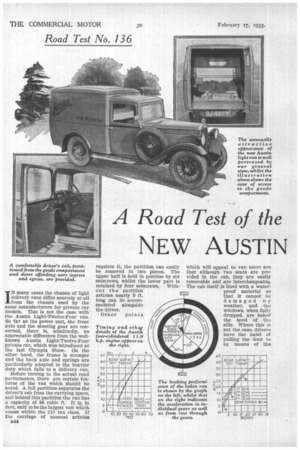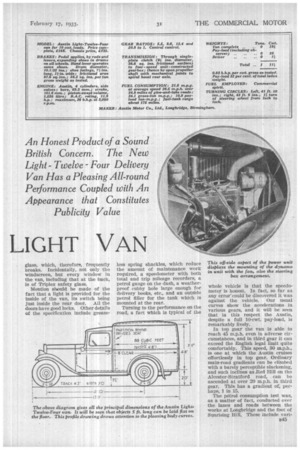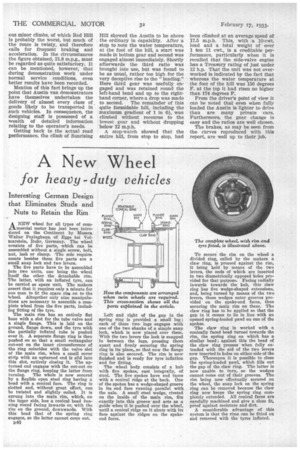A Road Test of the
Page 58

Page 59

Page 60

If you've noticed an error in this article please click here to report it so we can fix it.
NEW AUSTIN
LIGHT VAN IN many cases the chassis of light delivery vans differ scarcely at all from the chassis used by the same manufacturers for private car models. This is not the case with the Austin Light-Twelve-Four van. So far as the power unit, the front axle and the steering gear are concerned, there is, admittedly, no appreciable difference from the wellknown Austin Light-Twelve-Four private car, which was introduced at the last Olympia Show. On the other hand, the frame is stronger and the back axle and springs are particularly adapted to the heavier duty which falls to a delivery van.
Before turning to the actual road performance, there are certain features of the van which should be noted. A full partition separates the driver's cab from the carrying space, and behind this partition the van has a capacity of 88 cubic ft. It is, in fact, said to be the largest van which comes within the £15 tax class. If the carriage of unusual articles
al-1 requires it, the partition can easily be removed in two pieces. The upper half is held in position by six setscrews, whilst the lower part is retained by four setscrews. Without the partition' articles nearly 9 ft. long can be accommodated alongside the driver.
Other points
which will appeal to van users are that although two seats are provided in the cab, they are easily removable and are interchangeable. The cab itself is lined with a waterproof material so that it cannot be damaged by weather, and the windows, when fully dropped, are belov■1 the level of the sills. Where this is not the case, drivers have the habit of pulling the door to by means of the
glass, which, therefore, frequently breaks. Incidentally, not only the windscreen, but every window in the van, including that at the back, is of Triplex safety glass.
Mention should be made of the fact that a light is provided for the inside of the van, its switch being just inside the rear door. All the doors have good locks. Other details of the specification include grease
less spring shackles, which reduce the amount of maintenance work required, a speedometer with both total and trip mileage recorders, a petrol gauge on the dash, a weatherproof cubby hole large enough for delivery books, etc., and an outside petrol filler for the tank which is mounted at the rear.
Turning to the performance on the road, a fact which is typical of the whole vehicle is that the speedometer is honest. In fact, so far as any error' could be discovered it was against the vehicle. Our usual curves show the accelerations in various gears, and it will be seen that in this respect the Austin, despite a full 10-cwt. pay-load, is remarkably lively.
In top gear the van is able to reach 45 m.p.h. even in adverse circumstances, and in third gear it can exceed the English legal limit quite comfortably. This speed, 30 m.p.h., is one at which the Austin cruises effortlessly in top gear. Ordinary main-road gradients can be climbed with a barely perceptible slackening, and such inclines as Red Hill on the Alcester-Stratford road, can be ascended at over 20 m.p.h. in third gear. This has a gradient of, perhaps, 1 in 15.
The petrol consumption test was, as a matter of fact, conducted over the lanes and roads between the works at Longbriclge and the foot of Sunrising Hill, These include van
ens minor climbs, of which Red Hill is probably the worst, but much of the route is twisty, and therefore calls for frequent braking and acceleration. In the circumstances the figure obtained, 21.8 m.p.g., must be regarded as quite satisfactory. It can be mentioned, however, that during demonstration work under normal service conditions, even better results have been recorded.
Mention of this fact brings up the point that Austin van demonstrators have themselves undertaken the delivery of almost every class of goods likely to be transported in such vehicles. In consequence, the designing staff is possessed of a wealth of detailed information relating to the operator's needs.
Getting back to the actual road performance, the climb of Sunrising Hill showed the Austin to be above the ordinary in capability. After a stop to note the water temperature, at the foot of the hill, a start was made in bottom gear and second was engaged almost immediately. Shortly afterwards the third ratio was brought into use, but was found to be as usual, rather too high for the very deceptive rise to the "landing." Here third gear was usefully engaged and was retained round the left-hand bend and up to the righthand corner, where a drop was made to second. The remainder of this quite formidable hill, including the maximum gradient of 1 in 04, was climbed without recourse to the lowest gear and without dropping below 12 m.p.h.
A stop-watch showed that the entire hill, from stop to stop, had been climbed at an average speed of 17.5 m.p.h. This, with a 10-cwt. load and a total weight of over 1 ton 11 cvirt., is a creditable performance, particularly when it is recalled that the side-valve engine has a Treasury rating of just under 12 h.p. That the unit was not overworked is indicated by the fact that whereas the water temperature at the foot of the hill was 1513 degrees F. at the top it had risen no higher than 174 degrees F.
From the driver's point of view it can be noted that even when fully loaded the Austin is lighter to drive than are many private cars. Furthermore, the gear change is easy and the ratios are well chosen.
The brakes, as may be seen from the curves reproduced with this report, are well up to their job.




























































































